Shipyard



A shipyard (also called a dockyard) is a place where ships are repaired and built. These can be yachts, military vessels, cruise liners or other cargo or passenger ships. Dockyards are sometimes more associated with maintenance and basing activities than shipyards, which are sometimes associated more with initial construction. The terms are routinely used interchangeably, in part because the evolution of dockyards and shipyards has often caused them to change or merge roles.
Countries with large shipbuilding industries include China, Singapore, South Korea, Japan, Russia, Germany, the Netherlands, Sweden, Ukraine, Finland, Denmark, Australia, India, Brazil, Taiwan, Romania, Poland . The shipbuilding industry tends to be more fragmented in Europe than in Asia. In European countries there are a greater number of small companies, compared to the fewer, larger companies in the shipbuilding countries of Asia.
Most shipbuilders in the United States are privately owned, the largest being Huntington Ingalls Industries, a multibillion-dollar defense contractor, and the oldest family owned shipyard being Colonna's Shipyard in Norfolk, VA. The publicly owned shipyards in the US are Naval facilities providing basing, support and repair.
Shipyards are constructed nearby the sea or tidal rivers to allow easy access for their ships. In the United Kingdom, for example, shipyards were established on the River Thames (King Henry VIII founded yards at Woolwich and Deptford in 1512 and 1513 respectively), River Mersey, River Tees, River Tyne, River Wear and River Clyde – the latter growing to be the World's pre-eminent shipbuilding centre.
Sir Alfred Yarrow established his yard by the Thames in London's Docklands in the late 19th century before moving it northwards to the banks of the Clyde at Scotstoun (1906–08). Other famous UK shipyards include the Harland and Wolff yard in Belfast, Northern Ireland, where Titanic was built, and the naval dockyard at Chatham, England on the Medway in north Kent.
The site of a large shipyard will contain many specialised cranes, dry docks, slipways, dust-free warehouses, painting facilities and extremely large areas for fabrication of the ships.
After a ship's useful life is over, it makes its final voyage to a shipbreaking yard, often on a beach in South Asia. Historically shipbreaking was carried on in drydock in developed countries, but high wages and environmental regulations have resulted in movement of the industry to developing regions.
History
The world's earliest known dockyards were built in the Harappan port city of Lothal circa 2600 BC in Gujarat, India. Lothal's dockyards connected to an ancient course of the Sabarmati river on the trade route between Harappan cities in Sindh and the peninsula of Saurashtra when the surrounding Kutch desert was a part of the Arabian Sea.
Lothal engineers accorded high priority to the creation of a dockyard and a warehouse to serve the purposes of naval trade. The dock was built on the eastern flank of the town, and is regarded by archaeologists as an engineering feat of the highest order. It was located away from the main current of the river to avoid silting, but provided access to ships in high tide as well.
The name of the ancient Greek city of Naupactus means "shipyard" (combination of the Greek words ναύς naus ship, boat and πήγνυμι pêgnumi, pegnymi builder, fixer). Naupactus' reputation in this field extends to the time of legend, where it is depicted as the place where the Heraclidae built a fleet to invade the Peloponnesus.
In the Spanish city of Barcelona, the Drassanes shipyards were active from at least the mid-13th century until the 18th century, although it at times served as a barracks for troops as well as an arsenal. During its time of operation it was continuously changed, rebuilt and modified, but two original towers and part of the original eight construction naves remain today. It is currently a maritime museum.
Ships were the first items to be manufactured in a factory, several hundred years before the Industrial Revolution, in the Venice Arsenal, Venice, Italy. The Arsenal apparently mass-produced nearly one ship every day using pre-manufactured parts, and assembly lines and, at its height, employed 16,000 people.
Historic shipyards
- Lothal in Gujarat, India circa 2600 BC to 1900 BC
- Naupactus
- Roman shipyard of Stifone (Narni)
- Blackwall Yard 1614 to 1987
- Scotts Shipbuilding and Engineering Company, Greenock, Scotland, 1711–1984
- Kraljevica Shipyard established on 28 April 1729 and still operating yard
- Thames Ironworks and Shipbuilding Co. Ltd 1837 to 1912
- William Denny and Brothers, Dumbarton, Scotland 1840 to 1963
- John Brown & Company, Clydebank, Scotland 1851 to 1972
- Gdańsk Shipyard the birthplace of Solidarity Movement – (still a working yard)
- Swan Hunter – (closed in April 2006 and sold to Bharati Shipyards, India's second largest private sector shipbuilder)
- Harland and Wolff – (still a working yard)
- Cammell Laird – (still a working repair yard)
- Blohm + Voss, where Bismarck was constructed (still a major yard)
- Havana, long the only dockyard in the Caribbean during the colonial period, the Santísima Trinidad, largest warship of its time, was built there in 1769.
- Royal Naval Dockyards in the UK (including Woolwich, Deptford, Chatham, Portsmouth and Devonport), Gibraltar, Bombay, Bermuda, Hong Kong and elsewhere worldwide
- Bethlehem Steel Corporation had 15 shipyards during World War II
- Charlestown Navy Yard, later Boston Navy Yard, Boston, Massachusetts 1800 to 1974
- Ulstein Verft, Norway, established in 1917 (still a working yard under the Ulstein Group)
- Navy Island, Ontario, Canada – French in the 18th century, then British 1763 to War of 1812
- Mare Island Naval Shipyard, Mare Island, California, 1854 to 1996
- New York Naval Shipyard (NYNSY), also known as the Brooklyn Navy Yard, the New York Navy Yard, and United States Navy Yard, New York 1801 to 1966
- Philadelphia Naval Shipyard 1799 to 1995, at two locations
- San Francisco Naval Shipyard, later Hunters Point Naval Shipyard, then Treasure Island Naval Station Hunters Point Annex, 1941 to 1994
- Colonna's Shipyard 1875 to present- just 10 years after the War Between the States ended.
- Potrero Point, San Francisco, California, 1880s – still a working yard
- Long Beach Naval Shipyard, 1943 to 1997
- Golden Horn Shipyard, (Haliç Tersaneleri), Turkey, established in 1455 – still a working yard
- Portsmouth Naval Shipyard, located on Maine-New Hampshire border; Operational: 1800 to present, making it the oldest continuously-operating shipyard of the US Navy.
- Chantiers de l'Atlantique(STX France) - established in 1861 (still a working yard)
- Nantes-Indret, France - Establish in 1771 it built ships for the American Revolution including the Deane.
- 3. Maj – One of the largest shipyard in Mediterranean, established in 1892 in Rijeka (still a working yard)
- SLKB Komarno (Komárno) – Slovak Shipyard Komárno – European shipyard on Danube, established in 1898
- Lindstrom Shipyard 1899–1918 – (The shipyard was built in Aberdeen, Washington by John E. Lindstrom Jr. and associate Charles R. Green, Carl Almer Lindstrom (Designer), Andrew P. Lindstrom, John "Rigger" Johnson).
Prominent dockyards and shipyards
North America
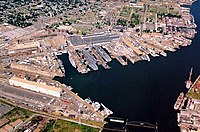
- Newport News Shipbuilding, (formerly Northrup Grumman Newport News) is the largest private ship builder in the US and the one best known for its unique capacity to build the Nimitz-class aircraft carriers.
- Ingalls Shipbuilding, part of Huntington Ingalls Industries, located in Pascagoula, Mississippi repaired the USS Cole and builds offshore drilling rigs, cruise ships and naval vessels.
- National Steel and Shipbuilding Company (NASSCO) shipyard in San Diego, California, part of General Dynamics; is the primary shipbuilding location on the west coast of the United States.
- Norfolk Naval Shipyard in Portsmouth, Virginia, is one of the largest shipyards in the world; specializing in repairing, overhauling and modernizing naval ships and submarines. It's the oldest and largest industrial facility that belongs to the United States Navy
- Electric Boat Division (EBDiv) of General Dynamics in Groton, Connecticut with an accessory facility in Quonset Point, Rhode Island, builder of many Naval submarines over the past 100 years, with some types built only here.
- Bath Iron Works (BIW), subsidiary of General Dynamics, is a major American shipyard located on the Kennebec River in Bath, Maine.
- Puget Sound Naval Shipyard in Bremerton, Washington, is also owned by the U.S. Navy. It services ships and submarines from the West Coast.
- The Portland, Oregon shipyard, operated by Cascade General Ship Repair (which is owned by Vigor Industrial)[1] is the largest such facility on the United States West Coast.
- The Louisiana Port is along the Mississippi river. It involves the Bollinger company in St. Rose.
- Talleres Navales del Golfo (TNG) at the Port of Veracruz, Mexico. Member of the Hutchison Port Holdings Group[2]
South America
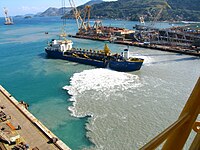
- The DIANCA shipyard in Puerto Cabello, Venezuela.
- SCRA[3] (Construction Refurbishment and Armament Service) with two dry docks, ready for naval and general vessel works.
- Punta de Lobos (Wolves Point) in west Montevideo, established in 1874.
- Punta Maua (Maua Point) in east Montevideo, established in 1872.
- Tsakos Industrias Navales S.A.[4]
- Cotecmar shipyard in Cartagena, Colombia. Cotecmar
- Enseada Industria Naval S.A., Bahia and Rio de Janeiro, Brazil
- The SIMA shipyard in Callao, Peru.
- Asenabra, in Duran, Ecuador. Established in 1990, more than 25 years of experience in naval repairs. 72.000m2 operating today, dry dock facilities will be available in 2016.
Europe
- Ferguson Shipbuilders is in Port Glasgow in inverclyde Scotland on the River Clyde. The Ferguson yard has been building ships for over a 110 years

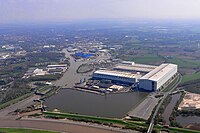
- BAE Systems Surface Ships operates three shipbuilding yards in the United Kingdom; Portsmouth, England and Scotstoun and Govan on the River Clyde in Glasgow, Scotland. Major projects include the Type 45 destroyer and the Queen Elizabeth class aircraft carriers.
- BAE Systems Submarine Solutions operates a major shipyard at Barrow-in-Furness in Cumbria, England. It is one of the few yards in the world capable of building nuclear submarines such as the Royal Navy's Vanguard class. Preceding companies such as Vickers Shipbuilding and Engineering have constructed hundreds of surface ships and civilian vessels in Barrow since the late 19th century.
- Fincantieri - Cantieri Navali Italiani S.p.A.[5] is an Italian shipbuilding company based in Trieste, Italy. It was formed in 1959 and is the largest shipbuilder in Europe, and one of the largest in the world. The company has built both commercial and military vessels during its history.
- Lürssen (or Lürssen Werft) is a German shipbuilding company based in Bremen-Vegesack. Lürssen designs and constructs yachts, naval ships and special vessels. Trading as Lürssen Yachts, it is one of the leading builders of custom superyachts.
- St Nazaire Atlantic Shipyards DCNS STX
- Odensee Shipyard
- Finland STX
- Russian shipyards in Vyborg, Kronstadt NovoAdmirality, Admiralty Baltic Verf Severnaja Verf Sevmash, Kaliningrad Baltic Verf, Murmansk areas, Zvezda and Vostok Raffles near Vladivostok along Dalzavod, Azovskaja SudoVerf and Zaliv, More, Sevastopol SMZ some of the main shipyards included largest ones.
- Kiel HDW
- Amsterdam Shipyards
- Hamburg Shipyards
- Emden Shipyard
- The Meyer Werft GmbH is one of the major German shipyards, headquartered in Papenburg at the river Ems. Founded in 1795 and starting with small wooden vessels, today Meyer Werft is one of world´s leading builders of luxury passenger ships. Altogether about 700 ships of different types have been built at the yard.
- Navantia is a Spanish shipbuilding firm, which offers its services to both military and civil sector.
- Cadis Navantia Shipyard
- Cernaval
- Lisnave
- Devonport Dockyard, located in the city of Plymouth, England in the county of Devon is the largest naval base in Western Europe. It has 15 dry docks, four miles (6 km) of waterfront, 25 tidal berths, five basins and covers 650 acres (2.6 km²). It is the main refitting base for Royal Navy nuclear submarines and also handles work on frigates. It is the base for seven of the Trafalgar class nuclear-powered hunter-killer submarines and many frigates, exploiting its convenient access to the Atlantic Ocean. It supports the Vanguard class Trident missile nuclear ballistic missile submarines in a custom-built refitting dock. It houses HMS Courageous, a nuclear-powered submarine used in the Falklands War and open to the general public.[6] Facilities in the local area also include a major naval training establishment and a base for the Royal Marines.
- Chatham Dockyard, located on the River Medway in Kent, was established as a royal dockyard by Queen Elizabeth I in 1567. For 414 years, the Dockyard provided over 500 ships for the Royal Navy, and was forefront of shipbuilding, industrial and architectural technology. At its height, it employed over 10,000 skilled artisans and covered 400 acres (1.6 km²). The dockyard closed in 1984, and most of the Georgian dockyard is now managed as a visitor attraction by the Chatham Historic Dockyard Trust.
- Sobrena in Brest, France. It operates 3 drydocks, up to 420 by 80 metres.
- Constanţa Shipyard (Romanian: Şantierul Naval Constanţa) is the largest shipyard in Romania and one of the largest in Europe having a market share of 20% in the Black Sea basin.[1] The shipyard has two drydocks, one used for the construction of ships up to 150,000 tonnes deadweight (DWT), and the second one used for the construction of ships up to 250,000 DWT, and two floating docks with a capacity of 8,000 tonnes and 15,000 tonnes.[2]
History, The Constanţa Shipyard was first mentioned as the Craft Repair Shop within the Constanţa Harbour area in 1892 by the Ministry for Public Works.[3] The first ship ever constructed by the shipyard and launched to sea on May 31, 1936 was a 12 metres (39 ft) long yacht named Crai Nou,[3] designed and built by Alexandru Theodoru a student at the Naval School in Constanţa and graduate of the French Naval School.[4] In 1950 the shipyard began to construct ships, pontoons, tugboats and towboats.[4] In 1975 the shipyard constructed one bulk carrier of 54,200 DWT which was the first large ship ever constructed in Romania.[4]
After the construction of a large bulk carrier Giuseppe Lembo in 1994, the shipyard reprofiled its activity to construct only small ships. Only after the privatisation in 2002 the shipyard restarted to construct large scale ships.[4] In the 114 years of existence the Constanţa Shipyard constructed 432 ships, 365 for Romanian shipping companies and 67 for shipping companies from Egypt, Russia, Greece, Japan, Hong Kong, Liechtenstein, Czech Republic, South Africa, Belgium, Germany, Italy, Norway, France, Panama and Netherlands, which have a total of 4,128,143 DWT.[4]
- Daewoo-Mangalia Heavy Industries or DMHI is a large shipyard located 45 kilometres (28 mi) south of the Port of Constanţa, in Mangalia, Romania. It was formed in 1997 as a joint venture between South Korean company Daewoo Shipbuilding & Marine Engineering and the 2 Mai Shipyard in Mangalia.[2 Since it was founded the company built over 127 new ships and repaired around 300 ships.
The shipyard is spread over an area of 980,000 square metres (10,500,000 sq ft), has three dry docks with a total length of 982 metres (3,222 ft) and 1.6 kilometres (0.99 mi) of berths.[4] In 2002 the company delivered two tankers of 42,500 DWT to the Norwegian company Kleven Floro used for the transportation of orange juice.[5] One of the main customers of the shipyard is the German company Hamburg Süd which ordered six container ships of around 6,000 TEU each, and seven ships of 7,100 TEU each as well as four tugboats.[6] The company also signed in 2005 an agreement with Mediterranean Shipping Company S.A., NSB Niederelbe, Gebab and Conti Reederei companies for the construction of 12 container ships of around 5,000 TEU each that will be delivered in stages until 2011 at a total cost of US$1.1 billion In 2008 the shipyard bought the largest gantry crane in North America, the Goliath Crane, formerly located in Quincy, Massachusetts from the General Dynamics company.[7] Built in 1975, the crane, nicknamed Goliath, Big Blue, The Dog or Horse, has a height of 100 metres (330 ft), a span of 126 metres (413 ft), a weight of 3,000 tonnes (6,600,000 lb) and a lifting capacity of 1,200 tonnes (2,600,000 lb).[8] The cranes's re-assembly has been under way since March 2009.
- Galați shipyard Galați is the largest naval shipyard on the Danube,given its strategic positioning inland but with access to the sea through either Sulina or Danube-Black Sea canal its output ranges from large tankers to research vessels, yachts and small coast guard patrol boats. The yard is known for taking on specialty projects and under Damen has completed over such 250 vessels since 1999.
- ROUSSE SHIPYARD WEST. The yard is located at the city of Ruse, Bulgaria, along the Danuve river. It is specialised in shipbuliding, shiprepair and manufacture of metal constructions. The yard owns the following main facilities: two piers with total length 605 meters; 14 buildling berths, 6 of which covered; traveling platform for shifting of the vessels; launching arrangement with capacity 1800 tons; additional floating arrangement for launching of vessels with weight up to 2200 t; covered production area of 69 decares including: cutting workshop, section assembly workshop, technical workshop, assembly workshop, pipe workshop and outfitting and delivery Department. The capacity of the yard allows building of vessels with the following dimensions: Length - 140 m; Breadth - 17 m; Deadweight - up to 8000 tdw.
East Asia
- Kawasaki Shipbuilding Corporation's Kobe Shipyard & Machinery Works in Japan builds oil tankers, LNG carriers, bulk carriers, container ships, Ro/Ro vessels, jetfoils and warships for the Japan Maritime Self-Defense Force
- Mitsui Engineering & Shipbuilding's Tamano Works builds bulk carriers, ore carriers, crude oil tankers, oil product carriers, LNG carriers, LPG carriers, reefers, container ships, pure car carriers, cargo ships, patrol vessels, ocean surveillance ships, training vessels, fishery patrol boats and fishing boats
- Mitsubishi Heavy Industries's Nagasaki Shipyard & Machinery Works primarily produces specialized commercial vessels, including LNG carriers, oil tankers and passenger cruise ships
- Hyundai Heavy Industries Ulsan Shipyard & Gunsan shipyard, in South Korea, is currently the largest in the world and has the capability to build a variety of vessels including Commercial Cargo, FPSO offshore, container ship, LNG Carrier,Car carriers, Tankers like VLCC & ULCC, Iron ore carrier and Naval vessels like Aegis destroyers & submarines.
- Hyundai Samho Heavy Industries Samho shipyard near Mokpo 4th largest South Korean shipyard for VLCC Oil tankers, container ships & LNG, Offshore, Subsidiary of Hyundai heavy industries.
- Hyundai Mipo dockyard, Ulsan bay shipyard chemical ships, LPG carriers, Special ships. Subsidiary of Hyundai Heavy Industries
- Yantai Raffles Shipyard, in Yantai, China, is that country's largest offshore builder. It employs the 20,000 ton crane Taisun, the holder of the Heavy Lift World Record.[7] Yantai Raffles' portfolio includes offshore platforms, pipe lay and other specialized vessels.
South East Asia
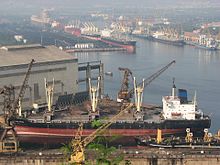
- Keppel Shipyard(Singapore)
- Jurong Shipyard Pte Ltd[8] (Singapore)
- Penguin Shipyard International, a subsidiary of Penguin International Limited[9] (Singapore)
- Hanjin shipyard in Subic, Zambales, Philippines
- Selat Melaka Shipbuilding Corporation[10] (Malaysia)
- PT Surya Prima Bahtera Heavy Industries,[11] in Batam, Indonesia.
- The Bangkok Dock Company[12] Sattahip, Thailand
- Marsun Company Limited (MCL)[13] Samutprakarn, Thailand
- Marine Acme Thai Dockyard (MAT)[14] Samutprakarn, Thailand
- Bason Shipyard, in Ho Chi Minh City, Vietnam, is a long-standing builder that was established by the French government in April, 1863 to repair warships and merchant vessels. Aside from its main function of building and repairing naval vessels, Bason also offers service to local and foreign customers from Southeast Asia and Europe.[15]
- PT. Dok Duasatu Nusantara in Jakarta, Indonesia.
- PT Kim Seah Shipyard Indonesia in Batam, Indonesia, a subsidiary of Penguin International Limited.[16]
- PT Karyasindo Samudra Biru Shipyard in Batam, Indonesia, a well-established steel and aluminium shipbuilder in the region.[17]
South Asia and the Middle East
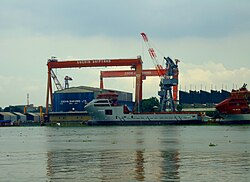


- Lavgan Dockyard Pvt. Ltd. India's newest ship repair facility (operational from June 2014). 106m x 26m Syncrolift and side transfer system.
- Western Marine Shipyard, a leading shipyard in Bangladesh based in Chittagong. The shipyard has been exporting ships and vessels to a number of European, Asian and African countries.
- Khulna Shipyard is the oldest shipyard in Bangladesh, situated in Khulna. It mainly produces warships for Bangladesh Navy. Recently it also started to build commercial vessels like cargo ship, container, oil tanker for local buyers.
- Ananda Shipyard and Shipways, one of the largest shipyards in Bangladesh, located in Narayanganj. It is a 100% export oriented shipyard.
- Pipavav Shipyard in Gujarat, India, is the leading, modern and largest engineering facility in the business of ships and offshore platforms construction, repair and conversion, heavy engineering and offshore engineering in South Asia.
- Colombo Dockyard in Colombo, Sri Lanka, is the largest engineering facility in the business of ship repair, shipbuilding, heavy engineering and offshore engineering in Sri Lanka.
- NorthStar Shipbuilding Pvt Limited[18] in New Mumbai, India, is one of the leading shipyard in India for small and mid-size ships.
- Sulkha Shipyard[19] builds a wide variety of ships. It has been in operation for 500 years.
- Cochin Shipyard in Kochi, India, is that country's largest shipyard. It is
- building the Vikrant class aircraft carrier.
- Garden Reach Shipbuilders and Engineers is located in India. It is owned by the Government of India and is constructing the Shardul class Large landing ship tank for the Indian Navy.
- Karachi Shipyard and Naval Dockyard in Karachi, Pakistan, is that country's first and oldest yard. It constructs cargo ships, tugboats, support vessels, and warships.
- Mazagaon Dockyard, operated by state-owned Mazagaon Dock Limited, is one of India's largest shipyards. It constructs a variety of ships both for the defence and civilian sector. The dockyard is known for constructing Britain's HMS Trincomalee. Currently the shipyard is building three Shivalik class frigates and three Kolkata class destroyers for the Indian Navy.
- The beach at Alang in the Indian state of Gujarat is the site of a large complex of shipbreaking yards. In 2010, the yard dismantled 357 ships; on average the yard processes 28-30 ships a month.[20]
- The Jebel Ali and Dubai ports in the UAE are capable of handling, constructing and repairing large ships. They also provide dry dock facilities.[21]
- The gate 7 of Shuwaikh port in the Kuwait has facility for repairing ships. They also provide dry dock facilities.[22]
- Lavgan Dockyard Pvt. Ltd. India's newest ship repair facility (operational from June 2014). 106m x 26m Syncrolift and side transfer system.
See also
References
- ^ "Vigor Marine". Vigor Industrial. Retrieved July 6, 2012.
- ^ "Company (about us)". TNG. Retrieved March 2, 2015.
- ^ "SCRA". SCRA. Retrieved July 6, 2012.
{{cite web}}: Cite has empty unknown parameter:|1=(help) - ^ "TSK". Tsakos Industrias Navales S.A. Retrieved July 6, 2012.
{{cite web}}: Cite has empty unknown parameter:|1=(help) - ^ E-mail * Saisissez votre adresse électronique. "STX Europe démantelé, Fincantieri va devenir le géant européen de la navale" (in French). Mer et Marine. Retrieved 2013-04-30.
- ^ "Submarine Museum marks Falklands 30th anniversary". BBC. May 2, 2012.
- ^ "Yantai Raffles' world-record gantry crane should see first lift this year - Offshore". Offshore-mag.com. Retrieved 2012-05-19.
- ^ "Jurong Shipyard Pte Ltd". Jurong Shipyard Pte Ltd. Retrieved May 6, 2014.
- ^ "Penguin Shipyard International".
- ^ "Selat Melaka Shipbuilding Corporation". Selat Melaka. Retrieved July 6, 2012.
- ^ "Surya Prima Bahtera Heavy Industries". SPB. Retrieved July 6, 2012.
- ^ "The Bangkok Dock Company (1957) Limited". The Bangkok Dock Company. Retrieved July 6, 2012.
- ^ "Marsun Company Limited". Marsun Company Limited. Retrieved July 6, 2012.
- ^ "Marine Acme Thai Dockyard". MAT. Retrieved July 6, 2012.
- ^ "Bason Shipyard's Brief History" (in Vietnamese). Bason Shipyard Website. Retrieved March 29, 2013.
- ^ "PT Kim Seah Shipyard Indonesia".
- ^ "PT Karyasindo Samudra Biru Shipyard Indonesia".
- ^ "NorthStar Shipbuilding Pvt Ltd". NorthStar Shipbuilding Pvt Ltd. Retrieved July 6, 2012.
- ^ "Sulkha Shipyard". Sulkha Shipyard. Retrieved July 6, 2012.
- ^ "Alang ship-breakers face Rs 2,000-cr hit from Rupee fall". The Economic Times. January 13, 2012.
- ^ http://www.drydocks.gov.ae/en/portal/contact.us.aspx
- ^ http://www.heisco.com
External links
- Drassanes at Barcelona – The Drassanes shipyard in Barcelona, with some original buildings dating to the 13th century.
- India based shipyards – India based shipyard.
- Sea Your History – Website from the Royal Naval Museum – Discover detailed information about Portsmouth Dockyard and the Royal Navy in the 20th century.
- U.S. Shipyards – extensive collection of information about U. S. shipyards, including over 500 pages of U. S. shipyard construction records
- Trading Places – interactive history of European dockyards
- Shipyards United States – from GlobalSecurity.org
- Gold Coast City Marina & Shipyard
- European shipyards – shipbuilding history in Hungary, Czechoslovakia and Slovakia
